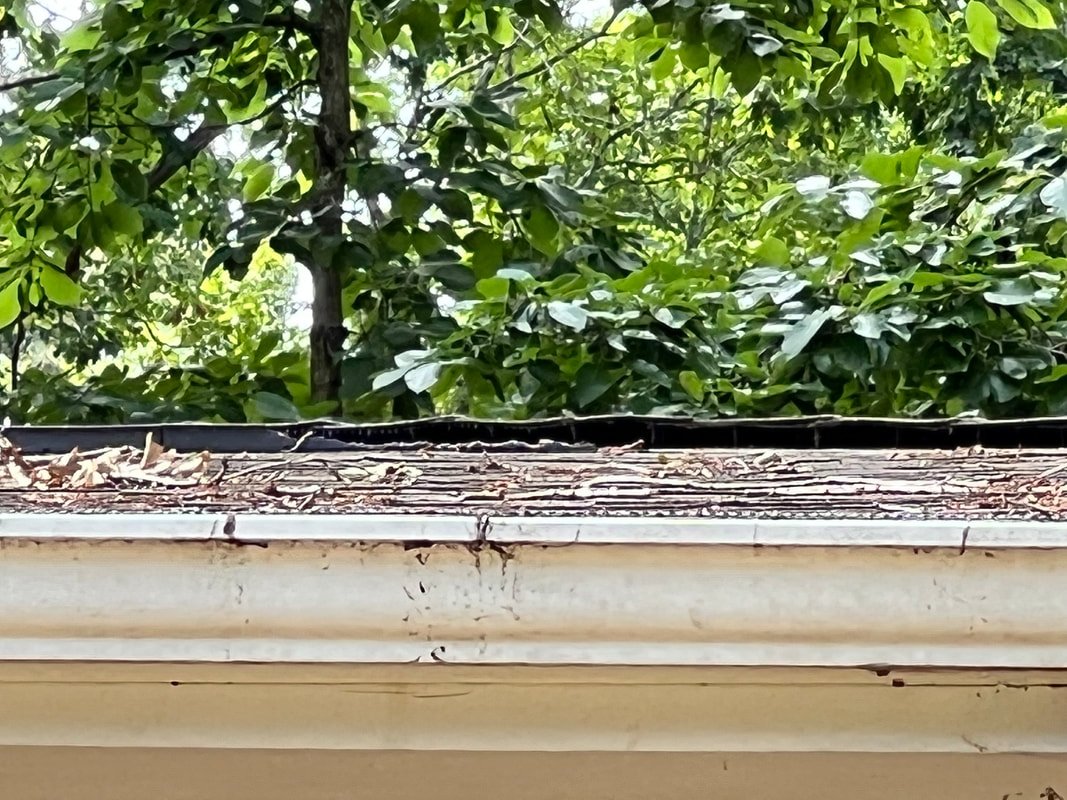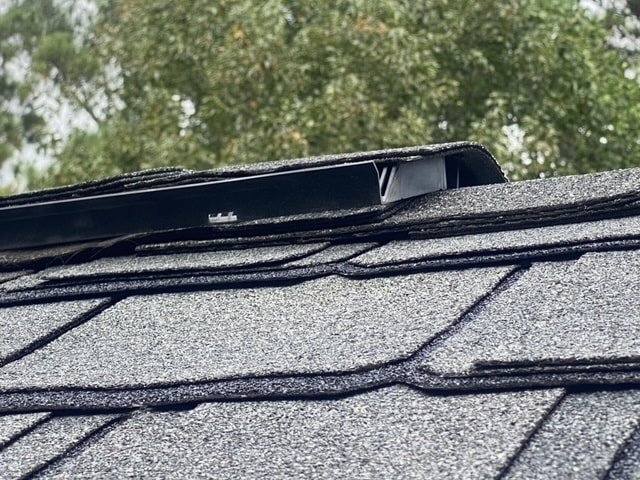
Wildlife-Proof Roof
An on-site assessment will pinpoint the vulnerable areas of your home's roof and what repairs or preventions are most appropriate.
What might wildlife prevention look like on the upper part of the home?
An on-site assessment will pinpoint the vulnerable areas of your home's roof and what repairs or preventions are most appropriate. The immediate opening or access point being used will need to be repaired. But animals follow the path of least resistance and will continue to explore your home. For this reason, we can offer preventative solutions to avoid damage in new areas.
To secure various areas of the roof we offer a process we call a Roof Detail. During the Roof Detail, technicians inspect your roof inch by inch sealing any small singular holes (which animals can use to excavate further) in any nook and corner of the roof.
Some of the most common wildlife entry points we see are along the roof edge (where shingles meet fascia), the ridge cap (ventilated cover that sits on the peak of the roof) the soffit (underside of the roof where it extends over the home), and gable vents (which allow airflow in the attic). We highlight these areas below.
Builders, roofers and renovators are great at what they do, but are not considering wildlife the way we do when they design and improve structures. Wildlife entry is not something humans tend to think about until it happens! So even if your home is new or immaculately maintained, there is often ample space for wildlife to settle in. But don't worry, you do not need to live in a steel fortress. If we've done our job right, repairs and preventions are essentially unnoticeable unless you know what to look for. We like to say, "Make it invisible. If it's visible, make it pretty."
Animals that we often find accessing through the roof and roofline include mice, rats, black rat snakes, squirrels, flying squirrels, bats and raccoons.
Gutter Guards & Drip Edge Flashing
The plywood decking under your shingles often does not reach the fascia (horizontal board at the end of the roof behind the gutters). This leaves a gap under the shingles where water wicks in and can rot your woodwork. Even before any rot has time to develop, explorative wildlife can simply slip under a shingle and scamper right into your attic.
Squirrels and flying squirrels love nesting in the soffit (behind the gutter and fascia, where the roof extends beyond the exterior walls). When we find squirrel nests in attics, 80% of the time it's in the soffit. Bats often use these roof edge gaps too! Drip edge flashing is a durable metal that slips under the shingles and covers this gap, sealing out water and wildlife.
Gutter guards keep leaves and other debris out of gutters, of course, keeping water flowing smoothly, avoiding dingy overflow, mosquitoes, and plants from sprouting from your roof. But they keep out wildlife as well. Squirrels and birds will nest in the gutter itself. This can cause the gutters to become clogged, and we often get calls for bird and squirrels stuck in down spouts! Squirrels can easily chew through or dislodge standard leaf guards. We use a heavy gauge aluminum designed with wildlife teeth, claws, and tenacity in mind.
Ridge Guards
The ridge line (or peak) of most roofs has an open vent running the length of it. This is called the ridge vent. It mitigates extreme heat and moisture build up in the attic. It's covered with a plastic cap called a ridge vent cap. Ideally, these fit tightly against the shingles. However, just one season of exposure to summer heat can cause the plastic cap to warp, lifting the nails and creating gaps. Ridge caps can also be made of a stiff metal that does not curve to meet dips in the roof, leaving gaps.
Gaps of a quarter inch or greater are common between the vent and shingles. That's all it takes to allow bats, flying squirrels, rats and more to enter the attic. Wildlife is remarkably adaptable. Many animals like squirrels and raccoons can easily chew right through the ridge vent cap to excavate a slightly larger hole to squeeze into. And it may look like nothing from the ground!
We install a durable form-fitting caging called Ridge Guard to protect the ridge vents. These are made from a rust-proof steel and crafted with care by AAC Distributing in the USA. Lengths of Ridge Guard are tailored to fit your ridge vent cap snuggly. An added benefit is protection from hurricane force winds that can rip off the cap as well as protection from many larger insects like wasps. Our team is certified by AAC to ensure proper installation techniques are used.








Soffit Pocket Reinforcement
The soffit is the underside of the roof where it extends from the exterior wall. As Did we mention squirrels love nesting in soffits? If squirrels and other wildlife can't get in through openings in the roof edge or the ridge, they often can get in directly through gaps in the soffit itself or chew new holes in vulnerable areas.
The shapes and quantities of soffit areas vary widely on homes. Wherever two surfaces come together one over the other, a comfy soffit pocket can be created where soffit meets shingles. A squirrel, for example, can sit on the shingles of one roof area and chew through the soffit board of another roof area just overhead. These soffit pockets are often a good area to responsively and preventatively secure as we can see where wildlife activity may lead once the immediate area is addressed.
Gable Vent Reinforcement
The gable vent is a louvered vent on the gable wall: the exterior wall that meets the peak of the roof. Gable vents can be a wide variety of sizes and shapes, but all have slats, usually wood, to keep water out while venting the attic. They are generally covered from the inside with a thin bug screen.
The bug screen disintegrates over time and can be chewed or clawed through by wildlife in a few quick movements. Mud daubers commonly build nests on the screens. When the nest falls off it, leaves a big hole in the bug screen. The wood louvers are often chewed through by squirrels and raccoons. Metal louvers can be bent to allow entry.
Bats use gable vents as-is. They are by far the most common animal we find in these vents. Gable vents are the perfect built-in bat houses! Bats slip in and hang from the inside, between the louvers and the bug screen. Their guano (or poop) and urine weighs on the bug screen, eventually rupturing it and giving the bats free reign of the attic itself. That's if they haven't already gotten through the ridge vent, soffit gaps or roof edge gaps. Heavy gauge metal screening installed on the gable vents tells wildlife to move along. Screening is painted to match your home, so it blends right in.
Other Structures We Check
Attic fan vents
Rooftop exhaust vents
Chimney/ chimney caps
Pipe boots
Gutter & soffit ends
Call Us: 919-903-6825
Humane Homes provides wildlife removal, repair, remediation and prevention to areas within 1 hour of Chapel Hill, North Carolina, including:
Apex, Bahama, Bonlee, Bonsal, Butner, Burlington, Bynum, Carrboro, Cary, Cedar Grove, Chapel Hill, Durham, Efland, Eli Whitney, Elon, Fearrington Village, Feltonville, Fuquay-Varina, Friendship, Garner, Gorman, Graham, Haw River, Haywood, Hillsborough, Holly Springs, Mandale, Mebane, Moncure, Morrisville, New Hill, Pittsboro, Raleigh, Saxapahaw, Siler City, Silk Hope, Snow Camp, Swepsonville, Sanford, and Wake Forest.
We also service the following counties: Alamance County, Chatham County, Durham County, Granville County, Lee County, Orange County, and Wake County.
Complete the fields in the form below. We will reach out promptly and get you scheduled.




